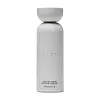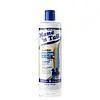What's inside
What's inside
 Key Ingredients
Key Ingredients

 Benefits
Benefits

 Concerns
Concerns

 Ingredients Side-by-side
Ingredients Side-by-side

Water
Skin ConditioningSodium Lauroyl Methyl Isethionate
CleansingGlycerin
HumectantCocamidopropyl Betaine
CleansingPolyquaternium-7
Polyquaternium-10
Glycol Distearate
EmollientHydrolyzed Rice Protein
Skin ConditioningLactobacillus
Skin ConditioningOlea Europaea Fruit Oil
MaskingMoringa Oleifera Seed Oil
EmollientAdansonia Digitata Seed Oil
EmollientNigella Sativa Seed Oil
EmollientArgania Spinosa Kernel Oil
EmollientRosmarinus Officinalis Leaf Oil
MaskingSodium Hyaluronate
HumectantHyssopus Officinalis Extract
MaskingCoco-Glucoside
CleansingGlyceryl Oleate
EmollientGuar Hydroxypropyltrimonium Chloride
Skin ConditioningHydrolyzed Hyaluronic Acid
HumectantEclipta Prostrata Extract
Skin ConditioningHibiscus Rosa-Sinensis Flower Extract
HumectantChlorella Ferment
Skin ConditioningTremella Fuciformis Polysaccharide
Emulsion StabilisingCaramel
Cosmetic ColorantSodium Phytate
1,2-Hexanediol
Skin ConditioningHydroxyethylcellulose
Emulsion StabilisingParfum
MaskingEthylhexylglycerin
Skin ConditioningPhenoxyethanol
PreservativeTrisodium Ethylenediamine Disuccinate
Sodium Benzoate
MaskingSodium Phosphate
BufferingCitric Acid
BufferingTocopherol
AntioxidantHydrogenated Palm Glycerides Citrate
EmollientDisodium Phosphate
BufferingPolysorbate 60
EmulsifyingBenzyl Alcohol
PerfumingPotassium Sorbate
PreservativeLactic Acid
BufferingLinalool
PerfumingWater, Sodium Lauroyl Methyl Isethionate, Glycerin, Cocamidopropyl Betaine, Polyquaternium-7, Polyquaternium-10, Glycol Distearate, Hydrolyzed Rice Protein, Lactobacillus, Olea Europaea Fruit Oil, Moringa Oleifera Seed Oil, Adansonia Digitata Seed Oil, Nigella Sativa Seed Oil, Argania Spinosa Kernel Oil, Rosmarinus Officinalis Leaf Oil, Sodium Hyaluronate, Hyssopus Officinalis Extract, Coco-Glucoside, Glyceryl Oleate, Guar Hydroxypropyltrimonium Chloride, Hydrolyzed Hyaluronic Acid, Eclipta Prostrata Extract, Hibiscus Rosa-Sinensis Flower Extract, Chlorella Ferment, Tremella Fuciformis Polysaccharide, Caramel, Sodium Phytate, 1,2-Hexanediol, Hydroxyethylcellulose, Parfum, Ethylhexylglycerin, Phenoxyethanol, Trisodium Ethylenediamine Disuccinate, Sodium Benzoate, Sodium Phosphate, Citric Acid, Tocopherol, Hydrogenated Palm Glycerides Citrate, Disodium Phosphate, Polysorbate 60, Benzyl Alcohol, Potassium Sorbate, Lactic Acid, Linalool
Water
Skin ConditioningSodium C14-16 Olefin Sulfonate
CleansingCocamidopropyl Betaine
CleansingCocamidopropyl Hydroxysultaine
CleansingSodium Cocoyl Isethionate
CleansingGlycerin
HumectantArgania Spinosa Kernel Oil
EmollientCocos Nucifera Oil
MaskingButyrospermum Parkii Butter
Skin ConditioningGlycol Distearate
EmollientHydrolyzed Rice Protein
Skin ConditioningGuar Hydroxypropyltrimonium Chloride
Skin ConditioningBiotin
AntiseborrhoeicPanthenol
Skin ConditioningTocopherol
AntioxidantArginine
MaskingSodium Hyaluronate
HumectantSodium Benzoate
MaskingCitric Acid
BufferingParfum
MaskingBenzyl Salicylate
PerfumingLinalool
PerfumingWater, Sodium C14-16 Olefin Sulfonate, Cocamidopropyl Betaine, Cocamidopropyl Hydroxysultaine, Sodium Cocoyl Isethionate, Glycerin, Argania Spinosa Kernel Oil, Cocos Nucifera Oil, Butyrospermum Parkii Butter, Glycol Distearate, Hydrolyzed Rice Protein, Guar Hydroxypropyltrimonium Chloride, Biotin, Panthenol, Tocopherol, Arginine, Sodium Hyaluronate, Sodium Benzoate, Citric Acid, Parfum, Benzyl Salicylate, Linalool
Ingredients Explained
These ingredients are found in both products.
Ingredients higher up in an ingredient list are typically present in a larger amount.
You may know this ingredient as argan oil. Argan Oil has antioxidant, hydrating, and soothing properties.
Studies have shown argan oil can help fight again radical damage from the sun. This makes it effective at preventing hyperpigmentation.
Large amounts of vitamin E found in argan oil helps the skin retain water. Argan oil also contains fatty acids such as linoleic acid, oleic acid, and palmitic acid. It is also a good source of lipids.
Another benefit of argan oil is skin-soothing. It can help reduce inflammation-related skin symptoms.
Argan Oil is effective at regulating sebum production in pores. This can make it effective at treating hormonal acne.
Traditionally, argan oil was used for its antibacterial and antifungal properties. However, argan oil contains fatty acids that may make it not fungal-acne safe.
Argan Trees are native to Morocco.
Learn more about Argania Spinosa Kernel OilCitric Acid is an alpha hydroxy acid (AHA) naturally found in citrus fruits like oranges, lemons, and limes.
Like other AHAs, citric acid can exfoliate skin by breaking down the bonds that hold dead skin cells together. This helps reveal smoother and brighter skin underneath.
However, this exfoliating effect only happens at high concentrations (20%) which can be hard to find in cosmetic products.
Due to this, citric acid is usually included in small amounts as a pH adjuster. This helps keep products slightly more acidic and compatible with skin's natural pH.
In skincare formulas, citric acid can:
While it can provide some skin benefits, research shows lactic acid and glycolic acid are generally more effective and less irritating exfoliants.
Most citric acid used in skincare today is made by fermenting sugars (usually from molasses). This synthetic version is identical to the natural citrus form but easier to stabilize and use in formulations.
Read more about some other popular AHA's here:
Learn more about Citric AcidCocamidopropyl Betaine is a fatty acid created by mixing similar compounds in coconut oil and dimethylaminopropylamine, a compound with two amino groups.
This ingredient is a surfactant and cleanser. It helps gather the dirt, pollutants, and other impurities in your skin to be washed away. It also helps thicken a product and make the texture more creamy.
Being created from coconut oil means Cocamidopropyl Betaine is hydrating for the skin.
While Cocamidopropyl Betaine was believed to be an allergen, a study from 2012 disproved this. It found two compounds in unpure Cocamidopropyl Betaine to be the irritants: aminoamide and 3-dimethylaminopropylamine. High-grade and pure Cocamidopropyl Betaine did not induce allergic reactions during this study.
Learn more about Cocamidopropyl BetaineGlycerin is already naturally found in your skin. It helps moisturize and protect your skin.
A study from 2016 found glycerin to be more effective as a humectant than AHAs and hyaluronic acid.
As a humectant, it helps the skin stay hydrated by pulling moisture to your skin. The low molecular weight of glycerin allows it to pull moisture into the deeper layers of your skin.
Hydrated skin improves your skin barrier; Your skin barrier helps protect against irritants and bacteria.
Glycerin has also been found to have antimicrobial and antiviral properties. Due to these properties, glycerin is often used in wound and burn treatments.
In cosmetics, glycerin is usually derived from plants such as soybean or palm. However, it can also be sourced from animals, such as tallow or animal fat.
This ingredient is organic, colorless, odorless, and non-toxic.
Glycerin is the name for this ingredient in American English. British English uses Glycerol/Glycerine.
Learn more about GlycerinGlycol Distearate serves as a pearlizing or opacifying agent in cosmetic products.
It's often included in cleansers and haircare products to give them a lustrous or shimmering appearance.
It is derived from stearic acid, a natural fatty acid commonly found in vegetable oils and animal fats.
Glycol Distearate isn't fungal acne safe.
Learn more about Glycol DistearateThis ingredient is derived from guar gum.
It is a conditioning ingredient, meaning it helps soften skin and hair.
Hydrolyzed Rice Protein is protein extracted from rice. This ingredient is rich in antioxidants and peptides.
Studies show this ingredient may help with blocking the melanin creation process when skin is exposed to UV.
Linalool is a fragrance and helps add scent to products. It's derived from common plants such as cinnamon, mint, citrus, and lavender.
Like Limonene, this ingredient oxidizes when exposed to air. Oxidized linalool can cause allergies and skin sensitivity.
This ingredient has a scent that is floral, spicy tropical, and citrus-like.
Learn more about LinaloolParfum is a catch-all term for an ingredient or more that is used to give a scent to products.
Also called "fragrance", this ingredient can be a blend of hundreds of chemicals or plant oils. This means every product with "fragrance" or "parfum" in the ingredients list is a different mixture.
For instance, Habanolide is a proprietary trade name for a specific aroma chemical. When used as a fragrance ingredient in cosmetics, most aroma chemicals fall under the broad labeling category of “FRAGRANCE” or “PARFUM” according to EU and US regulations.
The term 'parfum' or 'fragrance' is not regulated in many countries. In many cases, it is up to the brand to define this term.
For instance, many brands choose to label themselves as "fragrance-free" because they are not using synthetic fragrances. However, their products may still contain ingredients such as essential oils that are considered a fragrance by INCI standards.
One example is Calendula flower extract. Calendula is an essential oil that still imparts a scent or 'fragrance'.
Depending on the blend, the ingredients in the mixture can cause allergies and sensitivities on the skin. Some ingredients that are known EU allergens include linalool and citronellol.
Parfum can also be used to mask or cover an unpleasant scent.
The bottom line is: not all fragrances/parfum/ingredients are created equally. If you are worried about fragrances, we recommend taking a closer look at an ingredient. And of course, we always recommend speaking with a professional.
Learn more about ParfumSodium Benzoate is a preservative. It's used in both cosmetic and food products to inhibit the growth of mold and bacteria. It is typically produced synthetically.
Both the US FDA and EU Health Committee have approved the use of sodium benzoate. In the US, levels of 0.1% (of the total product) are allowed.
Sodium benzoate works as a preservative by inhibiting the growth of bacteria inside of cells. It prevents the cell from fermenting a type of sugar using an enzyme called phosphofructokinase.
It is the salt of benzoic acid. Foods containing sodium benzoate include soda, salad dressings, condiments, fruit juices, wines, and snack foods.
Studies for using ascorbic acid and sodium benzoate in cosmetics are lacking, especially in skincare routines with multiple steps.
We always recommend speaking with a professional, such as a dermatologist, if you have any concerns.
Learn more about Sodium BenzoateSodium Hyaluronate is hyaluronic acid's salt form. It is commonly derived from the sodium salt of hyaluronic acid.
Like hyaluronic acid, it is great at holding water and acts as a humectant. This makes it a great skin hydrating ingredient.
Sodium Hyaluronate is naturally occurring in our bodies and is mostly found in eye fluid and joints.
These are some other common types of Hyaluronic Acid:
Learn more about Sodium HyaluronateTocopherol (also known as Vitamin E) is a common antioxidant used to help protect the skin from free-radicals and strengthen the skin barrier. It's also fat soluble - this means our skin is great at absorbing it.
Vitamin E also helps keep your natural skin lipids healthy. Your lipid skin barrier naturally consists of lipids, ceramides, and fatty acids. Vitamin E offers extra protection for your skin’s lipid barrier, keeping your skin healthy and nourished.
Another benefit is a bit of UV protection. Vitamin E helps reduce the damage caused by UVB rays. (It should not replace your sunscreen). Combining it with Vitamin C can decrease sunburned cells and hyperpigmentation after UV exposure.
You might have noticed Vitamin E + C often paired together. This is because it is great at stabilizing Vitamin C. Using the two together helps increase the effectiveness of both ingredients.
There are often claims that Vitamin E can reduce/prevent scarring, but these claims haven't been confirmed by scientific research.
Learn more about TocopherolWater. It's the most common cosmetic ingredient of all. You'll usually see it at the top of ingredient lists, meaning that it makes up the largest part of the product.
So why is it so popular? Water most often acts as a solvent - this means that it helps dissolve other ingredients into the formulation.
You'll also recognize water as that liquid we all need to stay alive. If you see this, drink a glass of water. Stay hydrated!
Learn more about Water